The Flying Torpedo
The Flying Torpedo is a 1916 American silent drama directed by John B. O'Brien and Christy Cabanne. It was produced by the Fine Arts Film Company and distributed by the Triangle Film Corporation. The film was written by John Emerson (who also stars), Robert M. Baker and D. W. Griffith (who was not credited). The film is now considered lost.[1][2]
| The Flying Torpedo | |
|---|---|
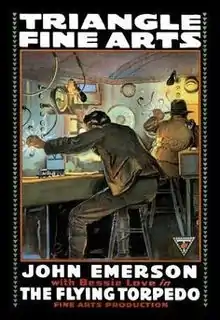 Film poster | |
| Directed by | John B. O'Brien Christy Cabanne |
| Produced by | D. W. Griffith |
| Written by | Robert M. Baker John Emerson D. W. Griffith (uncredited) |
| Starring | John Emerson Bessie Love |
| Cinematography | George W. Hill |
Production company | |
| Distributed by | Triangle Film Corporation |
Release date |
|
Running time | 50 minutes; 5 reels |
| Country | United States |
| Language | Silent (English intertitles) |
Plot
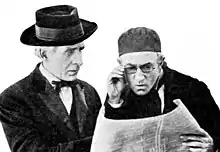
In 1921, novelist Winthrop Clavering (Emerson), known as "The World's Greatest Detective", befriends young inventor Bartholomew Thompson (Spottiswoode Aitken), has just invented a radio controlled flying bomb (weaponry that would come to be known as guided missiles).[1][3] Bartholomew is soon murdered by spies, described as "yellow men from the East" in the film, who steal his new invention. Clavering and his Swedish maid Hulda (Bessie Love) set out to find the spies who have been invading the United States. Clavering and Hulda catch up with spies just as they invade California and force them out of the country with the same device they stole.[4]
Cast
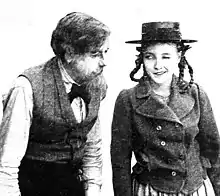
- John Emerson as Winthrop Clavering
- Spottiswoode Aitken as Bartholomew Thompson
- W. E. Lawrence as William Haverman
- Fred J. Butler as Chief of International Crooks
- Raymond Wells as Accomplice
- Lucille Young as Accomplice
- Eric von Stroheim as Accomplice
- Viola Barry as Adelaide E. Thompson
- Bessie Love as Hulda
- Ralph Lewis as Head of the Board
Eric von Stroheim played a small supporting role as an evil German officer.
Production notes
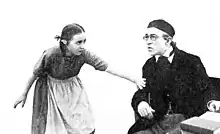
John Emerson had previously portrayed the role of Winthrop Clavering in the play The Conspiracy, from December 1912 to March 1914.[5]
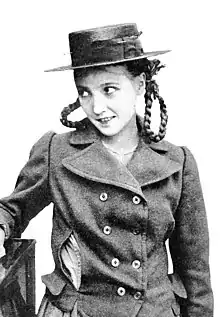
The film was produced by D. W. Griffith's film production company Fine Arts and was distributed by Triangle Film Corporation. Griffith also helped to write the film's scenario with lead John Emerson and Robert Baker.[2] Griffith was also responsible for casting a teenage Bessie Love in the film whom he discovered and cast in several of his films in 1915.[6] Filming began in July 1915 under the working title The Scarlet Band.[7] Christy Cabanne directed the battle sequences.[3]
References
- Citations
- Lennig, Arthur (2004). Stroheim. University Press of Kentucky. p. 37. ISBN 978-0-8131-3750-6.
- Soister 2012, p. 207
- Bennett, Carl (October 13, 2004). "Progressive Silent Film List: The Flying Torpedo". Silent Era. Retrieved January 6, 2015.
- Paris, Michael (1995). From the Wright Brothers to Top Gun: Aviation, Nationalism, and Popular Cinema. Manchester University Press. pp. 31–32. ISBN 978-0-7190-4073-3.
- Soister 2012, p. 209
- Soister 2012, pp. 209–210
- Soister 2012, p. 210
- Works cited
- Soister, John T. (2012). American Silent Horror, Science Fiction and Fantasy Feature Films, 1913–1929. McFarland & Company. ISBN 978-0-7864-8790-5.CS1 maint: ref=harv (link)
External links
| Wikimedia Commons has media related to The Flying Torpedo. |
